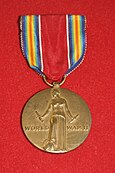
The Bronze Star Medal (BSM) is a United States Armed Forces decoration awarded to members of the United States Armed Forces for either heroic achievement, heroic service, meritorious achievement, or meritorious service in a combat zone.
The Commendation Medal is a mid-level United States military decoration presented for sustained acts of heroism or meritorious service. Each branch of the United States Armed Forces issues its own version of the Commendation Medal, with a fifth version existing for acts of joint military service performed under the Department of Defense.
The Antarctica Service Medal (ASM) was established by the United States Congress on July 7, 1960, under Public Law 600 of the 86th Congress. The medal was intended as a military award to replace several commemorative awards which had been issued for previous Antarctica expeditions from 1928 to 1941. With the creation of the Antarctica Service Medal, the following commemorative medals were declared obsolete;
The World War I Victory Medal was a United States service medal designed by James Earle Fraser of New York City under the direction of the Commission of Fine Arts.
The American Defense Service Medal was a military award of the United States Armed Forces, established by Executive Order 8808, by President Franklin D. Roosevelt, on June 28, 1941. The medal was intended to recognize those military service members who had served on active duty between September 8, 1939, and December 7, 1941.
The Citation Star was a Department of War personal valor decoration issued as a ribbon device which was first established by the United States Congress on July 9, 1918. When awarded, a 3⁄16-inch (4.8 mm) silver star was placed on the suspension ribbon and service ribbon of the World War I Victory Medal to denote a Citation (certificate) for "Gallantry In Action" was awarded to a soldier, or to a marine or attached to the Army's Second Division, American Expeditionary Forces. The Citation Star was replaced in 1932 with the introduction of the Silver Star Medal.

The Iraq Campaign Medal (ICM) is a military award of the United States Armed Forces which was created by Executive Order 13363 of U.S. President George W. Bush on 29 November 2004, and became available for general distribution in June 2005. The medal was designed by the U.S. Army Institute of Heraldry and was awarded during the Iraq War, from 19 March 2003 to 31 December 2011.
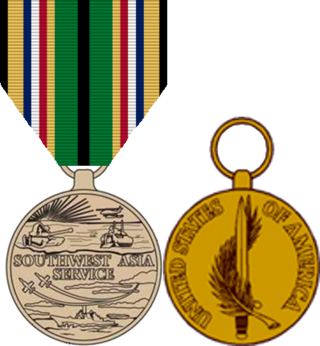
The Southwest Asia Service Medal is a military award of the United States Armed Forces which was created by order of President George H.W. Bush on March 12, 1991. The award is intended to recognize those military service members who performed duty as part of the Persian Gulf War and for a time thereafter. The medal was designed by Nadine Russell of the Army's Institute of Heraldry. The colors of the ribbon are tan, representing sand, with the black, white, red, blue, and green colors symbolizing the colors of coalition countries' national flags.
The European–African–Middle Eastern Campaign Medal is a military award of the United States Armed Forces which was first created on November 6, 1942, by Executive Order 9265 issued by President Franklin D. Roosevelt. The medal was intended to recognize those military service members who had performed military duty in the European Theater during the years of the Second World War.
The American Campaign Medal is a military award of the United States Armed Forces which was first created on November 6, 1942, by Executive Order 9265 issued by President Franklin D. Roosevelt. The medal was intended to recognize those military members who had performed military service in the American Theater of Operations during World War II. A similar medal, known as the American Defense Service Medal was awarded for active duty service before the United States' entry into World War II.
The Army of Occupation Medal is a military award of the United States military which was established by the United States War Department on 5 April 1946. The medal was created in the aftermath of the Second World War to recognize those who had performed occupation service in either Germany, Italy, Austria, Japan or Korea. The original Army of Occupation Medal was intended only for members of the United States Army, but was expanded in 1948 to encompass the United States Air Force shortly after that service's creation. The Navy and Marine equivalent of the Army of Occupation Medal is the Navy Occupation Service Medal, which features the same ribbon with its own medallion and clasps.
The Spanish War Service Medal was a United States military medal of the U.S. Army which was established by an act of the U.S. Congress on 9 July 1918. The medal recognizes those members of the Army and of the U.S. Volunteers who performed active duty during the Spanish–American War, but did not qualify for the Spanish Campaign Medal.

A medal ribbon, service ribbon or ribbon bar is a small ribbon, mounted on a small metal bar equipped with an attaching device, which is generally issued for wear in place of a medal when it is not appropriate to wear the actual medal. Each country's government has its own rules on what ribbons can be worn in what circumstances and in which order. This is usually defined in an official document and is called "the order of precedence" or "the order of wearing." In some countries, some awards are "ribbon only," having no associated medal.
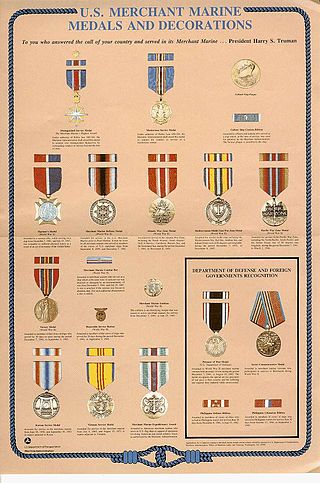
Awards and decorations of the United States Merchant Marine are civilian decorations of the United States which are issued to the members of the United States Merchant Marine for a variety of duties both in peace and war. Originally authorized to be issued by the War Shipping Administration of the World War II era, these awards were later issued by the Maritime Commission and are currently issued by the Department of Transportation's Martitime Administration.
The Philippine Presidential Unit citation Badge is a unit decoration of the Republic of the Philippines. It has been awarded to certain units of the United States military and the Philippine Commonwealth military for actions both during and subsequent to the Second World War.

The Merchant Marine Mediterranean-Middle East War Zone Medal (Bar) is a decoration of the United States Merchant Marine established by an Act of Congress on May 10, 1944.

The Jubilee Medal "Forty Years of Victory in the Great Patriotic War 1941–1945" was a state commemorative medal of the Soviet Union established on April 12, 1985, by decree of the Presidium of the Supreme Soviet of the USSR to denote the fortieth anniversary of the Soviet victory over Nazi Germany in World War II.
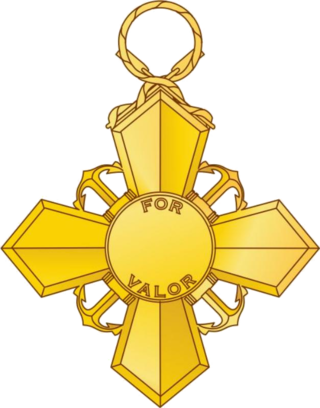
The Coast Guard Cross (CGC) is the United States Coast Guard's second highest military decoration for Coast Guardsmen who distinguish themselves extraordinary heroism in combat with an armed enemy force. Established by Act of Congress on 15 October 2010, it is intended to recognize members of the United States Coast Guard for extraordinary heroism in action. Coast Guardsmen serving under the Department of the Navy would be eligible for the Navy Cross. This medal, though approved, has not yet been awarded. By virtue of having never been awarded, it is the rarest United States military award.

The Merchant Marine World War II Victory Medal is a decoration of the United States Merchant Marine established by an Act of Congress on August 8, 1946.
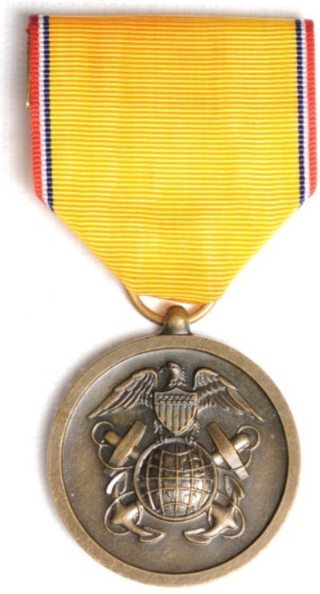
The Coast and Geodetic Survey Defense Service Medal is a decoration of the United States Coast and Geodetic Survey presented to personnel of the Coast and Geodetic Survey for service during the national emergency prior to the entry of the United States into World War II.
